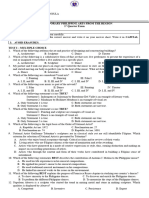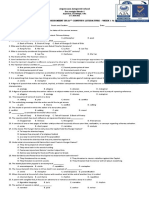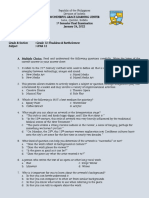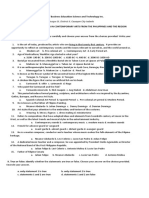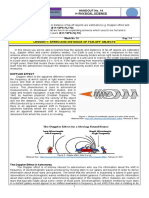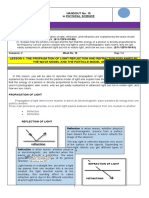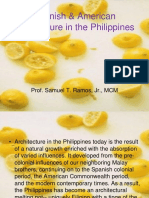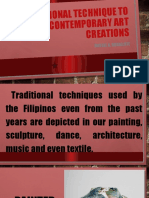LONG QUIZ Contemporary PAR
LONG QUIZ Contemporary PAR
Uploaded by
Dulce J. LuatonCopyright:
Available Formats
LONG QUIZ Contemporary PAR
LONG QUIZ Contemporary PAR
Uploaded by
Dulce J. LuatonOriginal Description:
Copyright
Available Formats
Share this document
Did you find this document useful?
Is this content inappropriate?
Copyright:
Available Formats
LONG QUIZ Contemporary PAR
LONG QUIZ Contemporary PAR
Uploaded by
Dulce J. LuatonCopyright:
Available Formats
Republic of the Philippines
Department of Education
Region VIII- Eastern Visayas
Schools Division of Calbayog City
Calbayog II District
CALBAYOG CITY NATIONAL HIGH SCHOOL
Calbayog City
LONG QUIZ IN
CONTEMPORARY PHILIPPINE ARTS FROM THE REGION
Name:______________________________________________________Year & Section: __________________Date: ____________
Subject Teacher: _________________________________________________________ Signature: ___________________________
I. Ethnic Tradition
1. A type of Philippine bamboo flute used by the Maguindanaon, half the size of the largest bamboo flute, the palendag.
a. Tumpong b. Sulibaw c. Karaga d. Trumpo
2. A hollow Igorot drum, topped with pig skin or lizard skin.
a. Tumpong b. Sulibaw c. Karaga d. Trumpo
3. It is a guitar made up of bamboo where the strings are slit from the bamboo itself.
a. Tumpong b. Sulibaw c. Karaga d. Trumpo
4. Choreographer of Ethnic Tradition Abdel Salaam has created an unusual dance style by smoothly blending African and other
ethnic forms with the modern dance of the 1990's.
a. Abdel Saalam b. Ahmir Khan c. Anthony Jovan Tan d. Jeilo A.Maga
5. This dance involves two people beating, tapping, and sliding bamboo poles on the ground and against each other in
coordination with one or more dancers who step over and in between the poles in a dance.
a. Rumba b. Singkil c. Tinikling d. Samba
6. A folk dance of the Maranao people of Lake Lanao based on the epic legend Darangen.
a. Rumba b. Singkil c. Tinikling d. Samba
7. A type of stilt house indigenous to the cultures of the Philippines. It is also known as payag or kamalig in other languages of
the Philippines.
a. Shrine b. Bahay Kubo c. Torogan d. Nipa hut
8. It is a traditional house built by the Maranao people of Lanao, Mindanao, Philippines (lit. "resting place" or "sleeping place").
a. Shrine b. Bahay Kubo c. Torogan d. Nipa hut
9. The Negrito were among the earliest humans to settle the Philippines. The first known were the people of the Tabon man
remains. The Negrito population was estimated in 2004 at around 31,000.Their tribal groups include the_____ and the _____.
a. Ate, Ayta b. Tae, Eta c. Ati, Aeta d. Ita, Eta
10. A collection of folk and ethnic art comprises all these attributes.
a. Philippine Batik b. Carving c. Pottery d. All of the above
II. Spanish Colonial Tradition
11. The Spanish colonization of the Philippine is from _______ to ________.
a. 1565 to 1898 b. 1566 to 1890 c. 1890-1899 d. 1430-1670
12. Is an ensemble of instruments and is used to accompany several Hispanic influenced song forms and dances.
a. Harana b. Rondalla c. Kundiman d. None of the above
13. It is a form of storytelling and entertainment which uses flat articulated figures (shadow puppets) to create the impression of
moving humans and other three-dimensional objects.
a. Moro Moro b. Carillo c. Zarzuela d. None of the above
14. This beautiful festival dance from the Mindoro was the premiere dance of the high society of Mindoro during the Spanish
period.
a. Mazurka Mindorena b. Mazurka Boholana c. Polka sa Nayon d. All of the above
15. During the Olden days, this dance was a favorite in social gatherings and was usually by young men and women who were
students of private school and colleges in Manila.
a. Mazurka Boholana b. Mazurka Mindorena c. Polka sa Nayon d. None of the above
16. It is the first written book in typography
a. Ang Barlaan at Josephat b. Mahiwagang Libro ni Cherry Gain c. Libro Delos Cuatro Postrimerias Del Hombre
17. It is a recreational garden and was once Manila's municipal cemetery built by the Dominicans during the Spanish colonial
period.
a. Paco Park b. Fort Santiago c. Intramuros d. All of the above
18. A citadel first built by Spanish conquistador, Miguel Lopez de Legazpi of the new established city of Manila in the Philippines.
a. Paco Park b. Fort Santiago c. Intramuros d. All of the above
19. First Spanish Written book in the Philippines.
a. Doctrina Christiana b. Nuestra Senora Del Rosario c. The Passion d. None of the above
20. Spanish colonialization introduced ____________ architecture into the country.
a. European b. Ethnic c. Canadian d. American
III. American Colonial Tradition
21. All but one are influences of American Colonialization in the Philippines
a. Schools b. Lovelife c. English Language d.Politics
22. He is the first painter of note for the 20th century and is often considered the brightest name in Filipino painting and certainly
the most important for the first quarter of the century.
a. Fabian dela Rosa b.Fernando Amorsolo y Cueto c. Jorge Pineda d. Dominador Castañeda
23. His landscapes are bathe in the glorious Philippine sunlight. His paintings, bursting with yellow-orange and golden sunlight,
captured the Philippine landscape in all the glory.
a. Fabian dela Rosa b.Fernando Amorsolo y Cueto c. Jorge Pineda d. Dominador Castañeda
24. In sculpture, he is the best known for his masterpiece, the “Boniface monument” in Caloocan completed in 1930, “Oblation”
and “Venus de Milo”.
a. Guillermo Tolentino b. Ireneo Miranda c. Pablo Amorsolo d. Dominador Castañeda
25. All but one were the Filipino architects who designed buildings during the American Colonial Period.
a. Tomas Mapua b. Juan Arellano c. Antonio Toledo d. Danilo Placidas
26. First editor of Philippine Journal of Education.
a. Kierlyn J. Acot-acot b. John Michael G. Rapal c. Francisco Benitez d. Zoilo Galang
27. The word comes from vaudeville, which was the first visible theatrical influence from America.
a. Bodol-bodol b. Bombilya c. Bodabil d. Bombay
28. During the colonization of America, the dance has created a great impact to us. __________________ is widely known for us.
it is a free for all dance disco.
a. Budots Dance b. Disco Dancing c. Kuratsa d. Cha-cha
29. This was a symphonic band formed in 1901 by Lt. Walter Loving of the US Army’s 48th Volunteer Infantry. On October 15,
1902, US Civil Governor General William Taft formally approved this band, originally composed of 400 volunteer male vocalist.
a. Philippine Constabulary Band b. Philippine Boy Band c. Philippine Orchestra d. Philippine Cosplay
30. It is incorporate with decorative sculptural elements hosed in a pediment, as exemplified the national art gallery
a. Classical Architecture b. Neoclassical Architecture c. Modern Architecture
IV. American Colonial Tradition
31. Popularly known as BenCab, is an award winning painter and printmaker who was tagged as a master of Philippine
Contemporary Art.
a. Benedict Cabrera b. Johnny Yes Papa c. Fernando Amorsolo d. Hernando Ocampo
32. “Grand Old man of the Philippine Art”
a. Benedict Cabrera b. Carlos Francisco c. Fernando Amorsolo d. Hernando Ocampo
33. It is definable broadly as the building style of the present day.
a. Contemporary Arts b. Contemporary Architecture c. Contemporary Buildings
34. The___________ is a multipurpose indoor arena at Ciudad de Victoria, a 140-heactre tourism enterprise zone in Bocaue and
Santa Maria, Bulacan, Philippines. With a maximum capacity of 55,00 people.
a. CCNHS MSS Hall b. Philippine Arena c. PICC Center d. Araneta Coliseum
35. All but one are the Popular Architects of the Philippine Contemporary Arts.
a. Juan Napkin b. Pablo Antonio c. Leandro V. Locsin d. Idelfonso P. Santos, Jr.
36. __________may include dance, music, opera, theatre and musical theatre, magic, illusion, mine, spoken word, puppetry,
circus arts, performance art, recitation and public speaking.
a. Performing arts b. Theatre Arts c. Contemporary Arts d. Modern Arts
37. __________is a collaborative form of fine art that uses live performers, typically actors or actresses, to present the experience
of a real or imagines event before a live audience in a specific place, often a stage.
a. Performing arts b. Theatre Arts c. Contemporary Arts d. Modern Arts
38. These are elements of Theatrical Performance.
a. Plot b. Character c. Thought d. Language/Diction
39. National artist for dance (1970) “The Mother of Contemporary Dance”
a. Alice Reyes b. Alice Dixon c. Alice in Wonderland d. Alice Kayo Dyan
40. Founded ballet manila in 1995 with Osias Barroso (her dancing partner).
a. Lisa Soberiano b. Lisa Macuja-Elizalde c. Lisa S. Ulo d. Lisa Maria-Elizaldo
V. Enumeration.
41-44. Four(4) Basic Theatre Stages.
_________________________________________________, _________________________________________________,
_________________________________________________, _________________________________________________,
45-50. Six(6) Elements of Contemporary Dance.
___________________________________, ___________________________________, ___________________________________,
___________________________________, ___________________________________, ___________________________________,
You might also like
- Diagnostic Examination Contemporary Philippine Arts From The RegionsDocument3 pagesDiagnostic Examination Contemporary Philippine Arts From The RegionsRoselyn Astronomo100% (1)
- Midterm Examination in Contemporary Philippine Arts From The RegionDocument2 pagesMidterm Examination in Contemporary Philippine Arts From The RegionArianne Kay Javier-Waban100% (1)
- Final Examination in Contemporary ArtsDocument8 pagesFinal Examination in Contemporary ArtsClifford LachicaNo ratings yet
- Pre Test in CPARDocument2 pagesPre Test in CPARJeffReyT.Ausan100% (4)
- Contemporary Arts - American Colonial Tradition (HUMSS 11-D)Document68 pagesContemporary Arts - American Colonial Tradition (HUMSS 11-D)Dulce J. Luaton100% (1)
- Evolution of Primitive DwellingsDocument34 pagesEvolution of Primitive DwellingsCrisencio M. Paner100% (6)
- Architecture of The PhilippinesDocument9 pagesArchitecture of The PhilippinesSam DichosoNo ratings yet
- Exam Contempo. 2022 2023Document3 pagesExam Contempo. 2022 2023Jonas Lancelot AtadNo ratings yet
- Contemporary Arts of The Region ExamDocument2 pagesContemporary Arts of The Region ExamArnel Boholst100% (1)
- 3rd Quarter Test Question CPARDocument3 pages3rd Quarter Test Question CPARAngelo GabrielNo ratings yet
- Cpar Third Quarter ExamDocument4 pagesCpar Third Quarter ExamGEMMA HIDALGO100% (1)
- 1st Quarter Exam in Grade 12Document3 pages1st Quarter Exam in Grade 12angelie cristine pomado50% (2)
- Cpar-Third-Quarter-Exam AnsweredDocument6 pagesCpar-Third-Quarter-Exam Answeredhilarion bacunoNo ratings yet
- 2nd Quarter Summative Assessment ContemporaryDocument2 pages2nd Quarter Summative Assessment Contemporaryjessica coronelNo ratings yet
- Summative Test in Contemporary Art (SECOND QUARTER) : SCHOOL YEAR 2019-2010Document2 pagesSummative Test in Contemporary Art (SECOND QUARTER) : SCHOOL YEAR 2019-2010RutchelNo ratings yet
- Answer-Key-Prelim-CparDocument2 pagesAnswer-Key-Prelim-CparHeicy LabuguenNo ratings yet
- Cpar Summative Test I Q3Document1 pageCpar Summative Test I Q3Char Layi100% (4)
- Midterm Reviewer CparDocument10 pagesMidterm Reviewer CparMark John Dumaslan100% (1)
- Second Summative Test in Contemporary Philippine Arts From The Region (3rd Quarter)Document3 pagesSecond Summative Test in Contemporary Philippine Arts From The Region (3rd Quarter)sunny slammyNo ratings yet
- Quiz ArtistDocument10 pagesQuiz ArtistElma DayolaNo ratings yet
- Summative Test 2 - Contemporary Arts (Quarter 3-Module 3 - 4)Document2 pagesSummative Test 2 - Contemporary Arts (Quarter 3-Module 3 - 4)Princess SaraNo ratings yet
- Cpaftr ExamDocument5 pagesCpaftr ExamMark Jay BongolanNo ratings yet
- Week 6 Living With ArtistDocument25 pagesWeek 6 Living With ArtistGrechen CabusaoNo ratings yet
- Department of Education: Malixi Integrated SchoolDocument3 pagesDepartment of Education: Malixi Integrated SchoolFlomarie Alferez100% (3)
- Exam in Contemporary Arts 1st MidtermDocument2 pagesExam in Contemporary Arts 1st Midtermcherrie r. de guzman100% (2)
- 1st Quarter Exam in Contempo..Document2 pages1st Quarter Exam in Contempo..May-Ann S. CahiligNo ratings yet
- Noel Contemporary Arts ReportDocument18 pagesNoel Contemporary Arts ReportNoelNo ratings yet
- CPAR 2019 SummativeDocument2 pagesCPAR 2019 SummativeJeffrey Pacayra75% (4)
- Contemporary 1st Quarter ExamDocument3 pagesContemporary 1st Quarter ExamGlenda Ortillano LeeNo ratings yet
- 1st Quarter Exam CPAR 2023-2024Document3 pages1st Quarter Exam CPAR 2023-2024maricar jodelah uyegNo ratings yet
- CAR Final ExamDocument3 pagesCAR Final Examfloramee.resulgaNo ratings yet
- Contemporary Philippine Arts From The Regions ScoreDocument4 pagesContemporary Philippine Arts From The Regions ScoreConje JessaNo ratings yet
- CPAR 1st Pre-Lim TestDocument2 pagesCPAR 1st Pre-Lim TestJessie Bautista100% (2)
- Schools Division Office I Pangasinan Magalong National High SchoolDocument4 pagesSchools Division Office I Pangasinan Magalong National High SchoolRichard Baysic100% (1)
- CPAR Summative Test Q2 2022 2023Document3 pagesCPAR Summative Test Q2 2022 2023Jaslor LavinaNo ratings yet
- 1st Quarter Examination Contemporary ArtsDocument4 pages1st Quarter Examination Contemporary ArtsNida Francisco100% (1)
- 21st Century Lit. Week 1 & 2Document2 pages21st Century Lit. Week 1 & 2Jundell DiazNo ratings yet
- CPAR 12 Final ExamDocument5 pagesCPAR 12 Final ExamRose Salvador100% (1)
- First Quarter Examination in CparDocument3 pagesFirst Quarter Examination in CparZenaida Hipolito100% (2)
- CPAR 3rd Quarter ExamDocument3 pagesCPAR 3rd Quarter ExamSORAHAYDA ENRIQUEZ100% (1)
- Warm - Up ActivityDocument3 pagesWarm - Up ActivityDesiree AllonesNo ratings yet
- Philippine National Artists in LiteratureDocument13 pagesPhilippine National Artists in LiteratureKawaii GlamourNo ratings yet
- CPAR-1st-Quarterly-Exam ANSWER KEYDocument5 pagesCPAR-1st-Quarterly-Exam ANSWER KEYMarrah TenorioNo ratings yet
- TQ Contemporary Art Part 2Document4 pagesTQ Contemporary Art Part 2Conje JessaNo ratings yet
- Contemporary Art - 1ST Quarterly ExamDocument2 pagesContemporary Art - 1ST Quarterly ExamChia Tan33% (3)
- Cpar Q1 Module 4 National Artists of The PhilippinesDocument71 pagesCpar Q1 Module 4 National Artists of The PhilippinesJane Marry Ignacio100% (1)
- Cpar MidtermDocument3 pagesCpar MidtermIvy DiazNo ratings yet
- CPAR PPT 01 Integrative Arts As Applied To Contemporary ArtsDocument13 pagesCPAR PPT 01 Integrative Arts As Applied To Contemporary ArtsCedric Kurt Taguba100% (2)
- Midterm Exam in CPARDocument4 pagesMidterm Exam in CPARBenilda Pensica Sevilla100% (2)
- DLP CPARRR January 9, 2019Document3 pagesDLP CPARRR January 9, 2019Ruby BieNo ratings yet
- Quiz 2Document2 pagesQuiz 2yannie isanan0% (1)
- CPAR PPT 3Document26 pagesCPAR PPT 3Wendy L. Gomez100% (2)
- Subject Matter and Style in Contemporary ArtDocument27 pagesSubject Matter and Style in Contemporary ArtKent Peter CuadradoNo ratings yet
- Characteristics of Contemporary ART: Philippine Arts From The RegionsDocument10 pagesCharacteristics of Contemporary ART: Philippine Arts From The RegionsSheena Kay Canonigo AbarcaNo ratings yet
- S.K. Pendatun Ave., Mo. Poblacion, Cotabato CityDocument3 pagesS.K. Pendatun Ave., Mo. Poblacion, Cotabato CitySarah Abas LptNo ratings yet
- Cpar Module 9Document22 pagesCpar Module 9Grechen CabusaoNo ratings yet
- Midterm CPAR Test QuestionaireDocument4 pagesMidterm CPAR Test QuestionaireRubs AD100% (1)
- Summative TestDocument2 pagesSummative Testtorjak shinNo ratings yet
- Q1. W1. Introduction To Philippine Contemporary Arts From The Regions and Its Various Forms and PracticesDocument6 pagesQ1. W1. Introduction To Philippine Contemporary Arts From The Regions and Its Various Forms and PracticesDazzle MuliNo ratings yet
- 2nd Sem 1st Periodical Exam CPAR 2022-2023Document4 pages2nd Sem 1st Periodical Exam CPAR 2022-2023Anne Cris Azor100% (1)
- Summative Test Contemporary Philippine Art For The Regions I-Multiple Choice. Write Your Answer in The Space ProvidedDocument2 pagesSummative Test Contemporary Philippine Art For The Regions I-Multiple Choice. Write Your Answer in The Space ProvidedRutchel0% (1)
- Burgos ST, District II, Cauayan City IsabelaDocument3 pagesBurgos ST, District II, Cauayan City IsabelaJanet PaggaoNo ratings yet
- Arts10 Q1 - Module-3Document21 pagesArts10 Q1 - Module-3Joshua DaywanNo ratings yet
- Inq, Invest & ImmWorksheet Week 5Document3 pagesInq, Invest & ImmWorksheet Week 5Dulce J. LuatonNo ratings yet
- Handout No. 2 in Inquiries, Immersion and Investigation: Co Qah + Melc LWDocument6 pagesHandout No. 2 in Inquiries, Immersion and Investigation: Co Qah + Melc LWDulce J. LuatonNo ratings yet
- Learning Worksheet No. 1 in Inquiries, Investigation & ImmersionDocument3 pagesLearning Worksheet No. 1 in Inquiries, Investigation & ImmersionDulce J. LuatonNo ratings yet
- WEEK 7 HandoutDocument5 pagesWEEK 7 HandoutDulce J. LuatonNo ratings yet
- Inq, Invest & ImmHandouts Week 1&2Document7 pagesInq, Invest & ImmHandouts Week 1&2Dulce J. LuatonNo ratings yet
- Chooses Appropriate Quantitative Research Design.: Handout No. 6 Ininquiries, Investigation and ImmersionDocument5 pagesChooses Appropriate Quantitative Research Design.: Handout No. 6 Ininquiries, Investigation and ImmersionDulce J. LuatonNo ratings yet
- WorksheetHandoutNo.12 MaryJoy v. ChiquilloDocument9 pagesWorksheetHandoutNo.12 MaryJoy v. ChiquilloDulce J. LuatonNo ratings yet
- Handout No. 8 in Inquiries, Investigation & Immersion: Co Qah + Melc LWDocument4 pagesHandout No. 8 in Inquiries, Investigation & Immersion: Co Qah + Melc LWDulce J. LuatonNo ratings yet
- Worksheethandoutno.9 John Paul LagramaDocument10 pagesWorksheethandoutno.9 John Paul LagramaDulce J. LuatonNo ratings yet
- DRRR HLAS Week 2 With AnswerskeyDocument9 pagesDRRR HLAS Week 2 With AnswerskeyDulce J. LuatonNo ratings yet
- DRRR HLAS Week 3Document11 pagesDRRR HLAS Week 3Dulce J. LuatonNo ratings yet
- Handout No. 11 in Physical ScienceDocument10 pagesHandout No. 11 in Physical ScienceDulce J. LuatonNo ratings yet
- DRRR HLAS Week 1Document4 pagesDRRR HLAS Week 1Dulce J. LuatonNo ratings yet
- LONG QUIZ Contemporary PARDocument2 pagesLONG QUIZ Contemporary PARDulce J. Luaton100% (1)
- WorksheetHandoutNo.14 MaryJoy v. ChiquilloDocument6 pagesWorksheetHandoutNo.14 MaryJoy v. ChiquilloDulce J. LuatonNo ratings yet
- Handout No. 10 in Physical Science: MelcDocument11 pagesHandout No. 10 in Physical Science: MelcDulce J. LuatonNo ratings yet
- WorksheetHandoutNo.13 MELVIN GRAFILDocument15 pagesWorksheetHandoutNo.13 MELVIN GRAFILDulce J. LuatonNo ratings yet
- Cpar 2019Document16 pagesCpar 2019Dulce J. LuatonNo ratings yet
- Worksheethandoutno.8 Shevan Claire AlinabonDocument15 pagesWorksheethandoutno.8 Shevan Claire AlinabonDulce J. LuatonNo ratings yet
- Contemporary Arts - American Colonial Tradition (HUMSS 11-D)Document68 pagesContemporary Arts - American Colonial Tradition (HUMSS 11-D)Dulce J. LuatonNo ratings yet
- Literature QuizDocument3 pagesLiterature QuizDulce J. Luaton100% (2)
- Literary Elements, Genres, TraditionsDocument45 pagesLiterary Elements, Genres, TraditionsDulce J. Luaton100% (5)
- Billy Collins: - Famous For Conversational, Witty Poems ThatDocument2 pagesBilly Collins: - Famous For Conversational, Witty Poems ThatDulce J. LuatonNo ratings yet
- Bayanihan Review Paper Gr. 11 H.e-ADocument3 pagesBayanihan Review Paper Gr. 11 H.e-AMariane Chavenia100% (5)
- Contemporary Philippine Arts From The RegionDocument44 pagesContemporary Philippine Arts From The RegionJohn Dave LarrozaNo ratings yet
- Filipino House - Bahay Na Bato PDFDocument13 pagesFilipino House - Bahay Na Bato PDFJazmine Pineda100% (1)
- National SymbolsDocument5 pagesNational SymbolsreignyfayeNo ratings yet
- Bahay Na Bato - Wikipedia PDFDocument95 pagesBahay Na Bato - Wikipedia PDFVivo Y53No ratings yet
- Pambansang Hayop: Mangga (Mangifera Indica)Document2 pagesPambansang Hayop: Mangga (Mangifera Indica)regie gadinNo ratings yet
- Nipa HutDocument4 pagesNipa HutLEAHCIM B. DRAGNEELNo ratings yet
- Tropical Design Theories Concepts and ST PDFDocument2 pagesTropical Design Theories Concepts and ST PDFAr CesNo ratings yet
- Architecture in The Philippines by Vakho MakasarashviliDocument12 pagesArchitecture in The Philippines by Vakho MakasarashviliikmvnNo ratings yet
- Modern Architecture in The Philippines and The Quest For Filipino Style PDFDocument7 pagesModern Architecture in The Philippines and The Quest For Filipino Style PDFKimberly LolongNo ratings yet
- ArchitectureDocument30 pagesArchitectureEiram LSNo ratings yet
- DeLeon Defining The Filipino Through The ArtsDocument39 pagesDeLeon Defining The Filipino Through The ArtsEloi Hernandez0% (1)
- Spanish American Architecture in The PhilippinesDocument33 pagesSpanish American Architecture in The PhilippinesJuliusNo ratings yet
- Brief History of ArchitectureDocument52 pagesBrief History of ArchitectureBless Redondo555No ratings yet
- Architecture of The PhilippinesDocument9 pagesArchitecture of The PhilippinesEmerson BolibolNo ratings yet
- Characteristics: Bahay KuboDocument6 pagesCharacteristics: Bahay KuboLESTER JOHN SALANGO100% (1)
- Tropical Design: Comparative Analysis of ChenesDocument18 pagesTropical Design: Comparative Analysis of ChenesHerald PadillaNo ratings yet
- Filipino Culture of Filling Up Space in A Gated CommunityDocument7 pagesFilipino Culture of Filling Up Space in A Gated CommunityCa NeraNo ratings yet
- Traditional Tecnnique To Contemporary Arts CreationsDocument43 pagesTraditional Tecnnique To Contemporary Arts CreationsDanica Oraliza AsisNo ratings yet
- By: Santos, R., Opay, C., & Hidalgo, J.: Contemporary Arts Presentation 01Document44 pagesBy: Santos, R., Opay, C., & Hidalgo, J.: Contemporary Arts Presentation 01Jhelynne G.No ratings yet
- History of Philippine ArchitectureDocument2 pagesHistory of Philippine ArchitectureGrendelle BasaNo ratings yet
- Debate 1Document2 pagesDebate 1Iris LucasNo ratings yet
- Page 107 113 CONTEMPORARY PHILIPPINE ARTS FROM THE REGIONDocument26 pagesPage 107 113 CONTEMPORARY PHILIPPINE ARTS FROM THE REGIONMrndyrNo ratings yet
- Bahay KuboDocument4 pagesBahay KuboLea Mendoza DanielNo ratings yet
- Notes For Soul and SpaceDocument19 pagesNotes For Soul and SpaceKathleen RosarioNo ratings yet
- Filipino Master PlannersDocument18 pagesFilipino Master Plannersbianca_torres_80% (1)
- Phil Arch StylesDocument77 pagesPhil Arch StylesLumina SnowNo ratings yet
- Vernacular Terms in Philippine ArchitectureDocument21 pagesVernacular Terms in Philippine ArchitectureDaniell Ives Casicas0% (2)





























